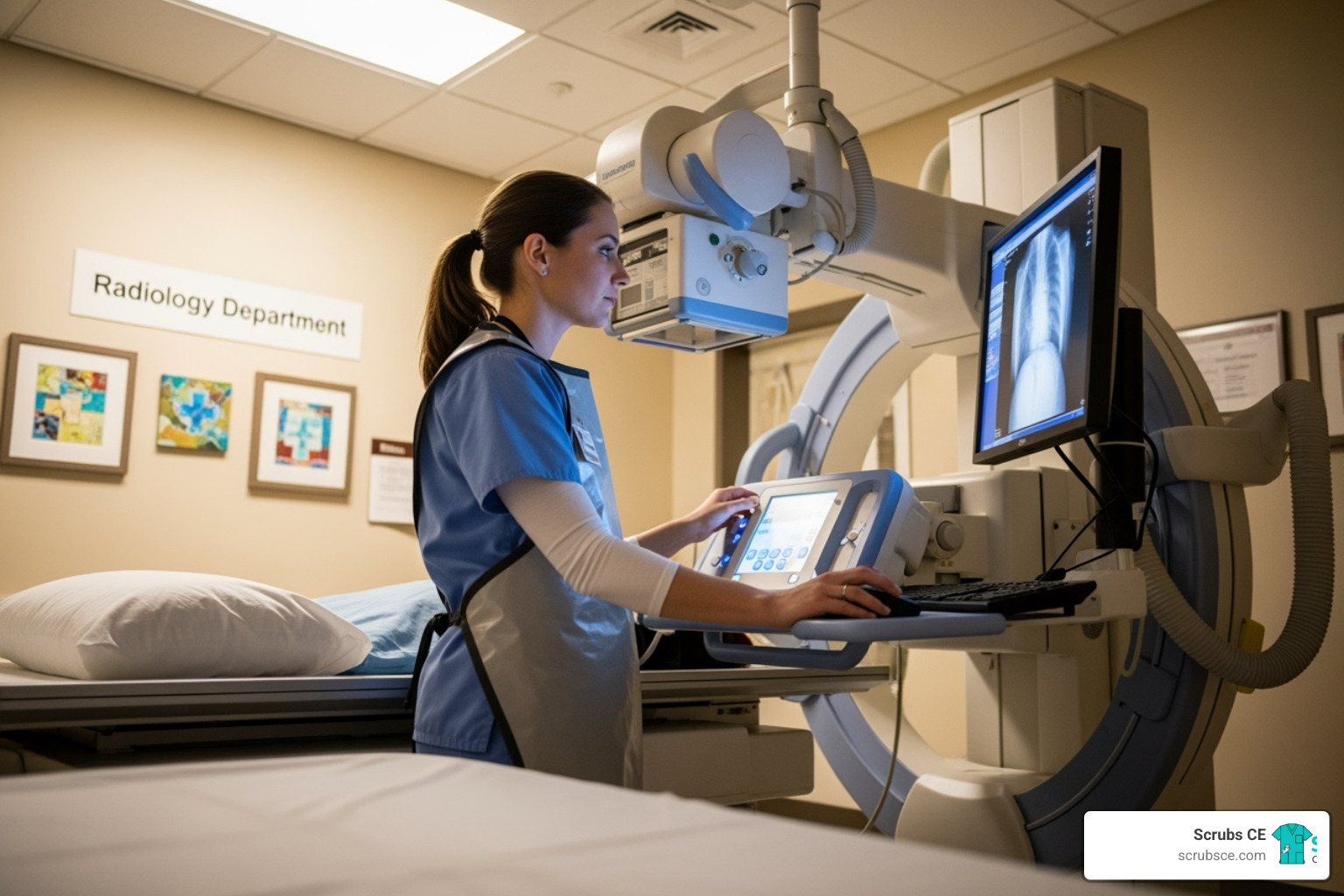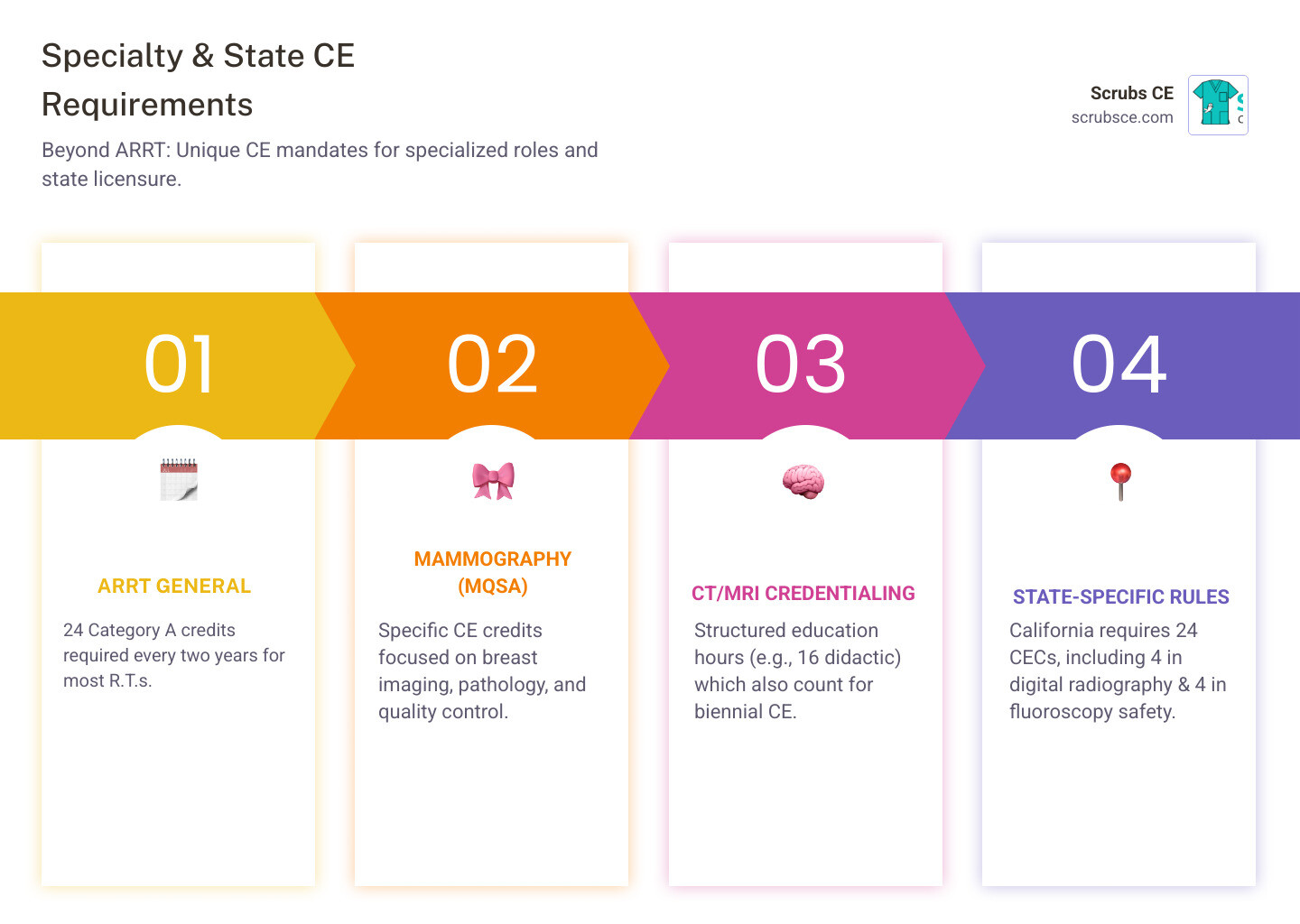Why X-Ray Tech CE Credits Matter for Your Career
X ray tech ce credits are mandatory continuing education requirements that X-ray technologists must complete to maintain their ARRT certification and state licensure. Here’s what you need to know:
Quick Answer:
- Standard Requirement: 24 CE credits every 2 years (biennium) for most radiologic technologists
- Credit Types: Category A or A+ credits from ARRT-approved providers
- Reporting Deadline: By the last day of your birth month at the end of your biennium
- Specialty Requirements: Additional credits may be required for mammography, CT, or state-specific licenses
- Consequences: Failure to complete requirements can result in certification probation or discontinuation
The field of medical imaging evolves rapidly. Continuing education is your pathway to providing the best possible patient care while protecting your professional credentials.
As one technologist noted after finding an affordable CE provider: “For the price, the CE credits and tracking alone are worth the membership. Best value for the money, especially for techs that need CE credits in a hurry.”
Understanding the CE landscape can feel overwhelming, with different requirements for ARRT certification, state licenses, and specialty modalities. Finding time and budget for courses adds to the stress.
The good news is that maintaining your credits is straightforward once you understand the framework. This guide breaks down everything you need to know—from decoding your biennium dates to finding affordable courses that fit your schedule.
Understanding Your Core CE Requirements
The American Registry of Radiologic Technologists (ARRT) sets the primary standards for continuing education, based on a two-year cycle known as a biennium. Understanding this cycle is the first step to staying compliant and stress-free.
The ARRT sets the national benchmark for professional excellence, ensuring certified radiologic technologists (R.T.s) continuously engage in professional development. Understanding these requirements helps you plan ahead and avoid a last-minute scramble. For a comprehensive overview, check out our guide on What You Need to Know About X-Ray Continuing Education Requirements.
How many x ray tech ce credits are required per biennium?
Most R.T.s need 24 approved x ray tech ce credits per two-year biennium. However, requirements vary based on your credentials:
- Registered Radiologist Assistant (R.R.A.): 50 approved CE credits per biennium.
- Sonography Credentials: 16 of the biennial CE credits must be sonography-related.
The ARRT has hinted that similar discipline-specific requirements might be introduced for other modalities in the future, so it’s smart to stay informed.
Earning additional credentials doesn’t typically change your primary CE credit count, unless you move to a higher-level credential like an R.R.A. For a more detailed breakdown custom to your specific credentials, check out How Many X-Ray CE Credits Do I Need for Radiography?.
What are the deadlines for completing and reporting CE?
Your biennium—the two-year period for completing your x ray tech ce credits—is tied to your birth month and the year you first passed an ARRT exam. It begins on the first day of your birth month and ends two years later on the last day of the month before your birth month.
After your biennium ends, you have until the last day of your birth month to report your completed credits during your annual renewal. This is a grace period for reporting, not for completing credits. You must complete all CE activities within your biennium. Missing the reporting deadline has serious consequences for your certification.
While your CE reporting dates remain consistent, the ARRT does offer some flexibility. In certain circumstances, you can request to change the year of your CE biennium if needed.
The bottom line is to mark your calendar and set reminders. Your future self will thank you for being proactive rather than panicking as the deadline approaches.
Navigating Accepted CE Activities and Credit Types
The ARRT has specific guidelines on acceptable x ray tech ce credits, including the activity type and provider. Understanding these rules ensures your efforts are recognized and you don’t waste valuable time. For more detailed information, Review ARRT’s Education Requirements for Obtaining and Maintaining Certification. Our courses, like Radiography Essentials for Limited Practice 6th ed. Ebook Test, are designed to meet these standards.
What is the difference between Category A and Category A+ CE credits?
When looking for x ray tech ce credits, you’ll encounter two main categories:
- Category A Credits: Approved by a Recognized Continuing Education Evaluation Mechanism (RCEEM), these are the standard for most technologists, including those in X-ray, mammography, nuclear medicine, radiation therapy, and CT.
- Category A+ Credits: Required for Registered Radiologist Assistants (R.R.A.s) and evaluated by a RCEEM+. They are accepted for other certifications but not required.
Always verify that an activity is approved by the appropriate ARRT-recognized RCEEM to ensure it counts towards your requirements.
What types of CE activities are accepted?
The ARRT accepts a variety of activities, offering flexibility in how you earn your x ray tech ce credits. Accepted activities include:
- Online and Homestudy Courses: Offer flexibility to learn at your own pace.
- Live Lectures and Conferences: Provide direct interaction and networking opportunities.
- Academic Courses: College or university courses count, with one semester credit typically equaling 16 CE credits and a quarter credit equaling 12.
- Advanced CPR Certification: Certifications like ACLS or PALS from ARRT-recognized providers can earn you up to six CE credits per biennium.
- Authoring Published Articles: Writing for ARRT-accepted peer-reviewed medical journals can earn significant CE credits.
- State Licensing CE: In some states (Florida, Kentucky, Massachusetts, or Oregon), activities for state licensure may also count toward ARRT requirements.
Activities that are not accepted include:
- Clinical instructorships
- Earning a new credential itself (though the coursework may count)
- Basic Life Support (BLS) certification
- Non-clinical topics (e.g., billing, stress management) or modalities outside your certification.
Our Part 1 Radiation Protection for X-Ray Procedures E-Course Test is an example of an accepted online course designed to meet these rigorous standards.
Finding and Completing Your X-Ray Tech CE Credits
Once you know the requirements, the next step is finding approved courses that fit your schedule and budget. The rise of online CE has been a game-changer for busy professionals, offering the flexibility to complete credits anytime, anywhere.
As one technologist shared, “I can pick any CE article, take the quiz, and have my CE done anywhere, anytime. It’s definitely worth the price!” This convenience means learning fits into your life, not the other way around. You can explore more about these advantages in our article on the Benefits of Taking X-Ray Continuing Education Courses.
Where can X-ray technologists find approved CE courses?
Finding approved x ray tech ce credits is straightforward if you know where to look.
- ARRT Biennial CE Search Tool: This is the best place to search for and verify approved Category A and A+ activities.
- Professional Organizations: These groups often offer comprehensive CE libraries as part of their membership benefits. Their courses are vetted and reliable.
- Dedicated Online CE Providers: Companies like Scrubs CE specialize in accessible and straightforward education. Our platform at Scrubs CE X-Ray CEU Courses offers a wide range of self-paced, ARRT-approved activities with instant certificate delivery. You can also browse our complete selection at Continuing Education Courses for X-Ray Technologists.
- State Licensing Board Websites: Check your state board’s website for lists of approved providers, especially if you have state-specific requirements.
When evaluating a provider, look for clear accreditation information and testimonials from other technologists. Need to get started quickly? We’ve put together a guide on How to Enroll in X-Ray CE Fast.
What are the costs and are there affordable options?
The cost of x ray tech ce credits varies, but budget-friendly options are available.
- Per-Credit Pricing: This model allows you to pay for individual courses, but costs can add up quickly when you need 24 credits.
- Annual Memberships: Often the most cost-effective solution, memberships offer unlimited access to a CE library for a flat yearly fee. This provides exceptional value, allowing you to complete your requirements for a low annual cost.
- Group Rates: This is a great option for departments or imaging centers to secure discounted pricing for their staff.
At Scrubs CE, we focus on providing affordable, high-quality education. Our platform is designed to be convenient and stress-free, helping you invest in your career without financial burden.
Specialty and State-Specific CE Requirements
Beyond the ARRT’s national standards for x ray tech ce credits, many states and specialty areas have their own unique CE requirements. It’s essential to understand all layers of requirements that apply to you to ensure you maintain expertise in your specific modality. Pursuing specialty-specific CE can also help you explore other modalities and advance your career.
| Credential/State | CE Credits Required | Specific Requirements |
|---|---|---|
| Standard Radiography (ARRT) | 24 credits per biennium | Category A credits from RCEEM-approved providers |
| Mammography | 15 credits every 3 years | Must meet MQSA requirements; includes 8 hours in specific mammography topics |
| CT/MRI New Credentials | Varies | Structured education programs; credits may count toward biennial CE |
| California CRT | 24 CECs per biennium | Must include 4 credits in digital radiography and 4 credits in fluoroscopy safety (if holding fluoroscopy permit) |
| Sonography | 16 discipline-specific credits | Out of the standard 24 biennial credits, 16 must be sonography-related |
| Registered Radiologist Assistant | 50 credits per biennium | Category A+ credits from RCEEM+ approved providers |
How do requirements differ for specialties like Mammography or CT?
Specialized modalities require specific continuing education beyond your standard x ray tech ce credits.
- Mammography: Under the Mammography Quality Standards Act (MQSA), technologists must complete 15 CME units every three years, with at least eight hours on mammography-specific topics.
- CT or MRI: Structured education programs required for new credentials in these areas can often count toward your biennial CE requirements.
- Sonography: 16 of your 24 biennial credits must be directly related to sonography.
- Fluoroscopy: Many states mandate specific CE in radiation safety for fluoroscopy due to the higher doses involved.
Our courses, like The Top X-Ray Continuing Education Courses That Pay Off in the Long Run, are designed to help you meet both general and specialty-specific requirements efficiently.
How do I meet specific state requirements like California or Florida?
State licensing boards often have rules that differ from the ARRT. Always verify a course is accepted by your state board before you invest time and money.
- California has very specific rules: CRTs need 24 CECs every two years, including 4 credits in digital radiography. If you have a fluoroscopy permit, you need an additional 4 credits in fluoroscopy safety. Check the California Department of Public Health rules for full details.
- Florida and Texas also have their own state-specific requirements managed by their respective state boards.
The key is to always verify state acceptance. At Scrubs CE, we offer courses that meet many state-specific requirements, including California’s. Our course Radiography in the Digital Age 3rd ed. Test Only Emailed is designed with these varied requirements in mind.
Introduction
Staying current in the evolving field of medical imaging is a requirement. For X-ray technologists, continuing education (CE) credits are essential for maintaining certification and state licensure. This guide covers everything you need to know about x ray tech ce credits, from understanding the requirements to finding and reporting your courses.
The Importance of Continuing Education (CE) for X-Ray Technologists; Certification maintenance; State licensure; Career advancement; Patient safety.
Understanding Your Core CE Requirements
The American Registry of Radiologic Technologists (ARRT) sets the CE standards on a two-year cycle called a biennium. Knowing your dates and totals prevents last-minute stress. You can dive deeper with our guide on What You Need to Know About X-Ray Continuing Education Requirements.
How many x ray tech ce credits are required per biennium?
Most R.T.s need 24 approved x ray tech ce credits per biennium. Exceptions include: R.R.A.s (50 credits) and those with a Sonography credential, where 16 of the 24 must be sonography-specific. Adding credentials typically doesn’t change your 24-credit total unless you move to a higher-level role like R.R.A. For details, see How Many X-Ray CE Credits Do I Need for Radiography?.
What are the deadlines for completing and reporting CE?
Your biennium starts on the first day of your birth month and ends two years later on the last day of the month before your birth month. You then have until the last day of your birth month to report during renewal. Complete all credits within the biennium; the extra time is for reporting only. In limited cases, you can request to change the year of your CE biennium.
Navigating Accepted CE Activities and Credit Types
The ARRT defines what counts toward your x ray tech ce credits. Always verify activities against ARRT rules: Review ARRT’s Education Requirements for Obtaining and Maintaining Certification. Many of our courses, like Radiography Essentials for Limited Practice 6th ed. Ebook Test, meet these standards.
What is the difference between Category A and Category A+ CE credits?
- Category A: Approved by a RCEEM; standard for most technologists.
- Category A+: Evaluated by a RCEEM+; required for R.R.A.s (accepted for others but not required).
What types of CE activities are accepted?
Accepted examples:
- Online and homestudy courses
- Live lectures, conferences, and academic courses (1 semester credit = 16 CE; 1 quarter credit = 12)
- Advanced CPR like ACLS/PALS from ARRT-recognized providers (up to 6 per biennium)
- Authoring peer-reviewed publications
- Certain state licensing CE (varies by state)
Not accepted:
- Clinical instructorships
- Earning the new credential itself
- Basic Life Support (BLS)
- Non-clinical topics or modalities outside your certification
A good fit: our Part 1 Radiation Protection for X-Ray Procedures E-Course Test.
Finding and Completing Your X-Ray Tech CE Credits
Online CE makes meeting your requirements flexible and fast. As many techs note, being able to learn anywhere, anytime is a game-changer. Learn more about the benefits here: Benefits of Taking X-Ray Continuing Education Courses.
Where can X-ray technologists find approved CE courses?
- ARRT Biennial CE Search Tool: Verify Category A/A+ activities.
- Professional organizations: Reliable libraries vetted for quality.
- Dedicated online CE providers: Scrubs CE offers self-paced, ARRT-approved courses with instant certificates: Scrubs CE X-Ray CEU Courses and our full catalog Continuing Education Courses for X-Ray Technologists.
- State-approved lists: Check your board for any additional requirements.
What are the costs and are there affordable options?
- Per-credit pricing: Pay as you go; costs can add up to 24 credits.
- Annual memberships: Typically the best value. Scrubs CE offers access to 240+ credits for around $55/year.
- Group rates: Cost-effective for departments.
Ready to start quickly? See How to Enroll in X-Ray CE Fast.
Specialty and State-Specific CE Requirements
In addition to ARRT standards, specialties and states may add requirements for x ray tech ce credits. Exploring these can support career growth: X-Ray Continuing Education Offers a Pathway to Explore Other Modalities.
How do requirements differ for specialties like Mammography or CT?
- Mammography (MQSA): Specific CE on breast anatomy, pathology, positioning, and QC—beyond general ARRT credits.
- CT/MRI: ARRT “structured education” for new credentials; these hours can often count toward biennial CE.
- Sonography: 16 of 24 credits must be sonography-specific.
- Fluoroscopy: Many states require radiation safety-focused CE.
Courses like Radiography in the Digital Age 3rd ed. Test Only Emailed and The Top X-Ray Continuing Education Courses That Pay Off in the Long Run can help.
How do I meet specific state requirements like California or Florida?
- California (CDPH-RHB): 24 CECs every two years for CRTs, including 4 in digital radiography; +4 fluoroscopy safety CECs if you hold the permit. Mammography certificate holders need mammography-specific CECs. Details: California Department of Public Health rules.
- Florida/Texas: State boards set additional rules—confirm acceptance before enrolling.
Key takeaway: ARRT approval doesn’t guarantee state approval. Verify both.
Reporting Credits, CQR, and Consequences of Non-Compliance
Completing your x ray tech ce credits is only half the battle; you must also report them correctly and on time. This diligence is critical for protecting your certification, as detailed in Radiologic Technologists Jobs: The Importance of X-Ray Continuing Education.
How should I report my completed x ray tech ce credits?
You report CE activities to the ARRT during your online annual renewal, which starts two months before your birth month. You will enter the details for each completed course.
You must keep copies of your completion certificates. The ARRT conducts random CE audits, and if selected, you must provide proof of completion for all reported credits.
State board reporting processes vary; some allow electronic submission by providers, but for most, you are responsible for manual entry. Ensure all information is correct before submitting your renewal.
What are the consequences of not meeting CE requirements?
Failing to meet CE requirements on time can have significant professional repercussions.
- CE Probation: If you miss the deadline, your certification is placed on probation, giving you a six-month extension to complete the credits.
- Discontinued Certification: Failure to correct the deficiency during probation can lead to your ARRT certification being discontinued.
- Impact on State License and Employment: A discontinued ARRT certification will likely affect your state license and ability to work legally.
- Reinstatement Process: Reinstating a discontinued certification is a complex and costly process.
The bottom line is to stay on top of your CE requirements. Proactive planning and utilizing convenient online resources can help you avoid these stressful and career-damaging situations.
Conclusion
Navigating x ray tech ce credits is a manageable and rewarding part of your professional journey. A little regular attention keeps your career running smoothly.
This guide covered the essentials: most R.T.s need 24 CE credits every two years during a biennium tied to their birth month. You must complete credits within the biennium and report them by the deadline.
We clarified that most technologists need Category A credits and that accepted activities range from online courses to advanced CPR, while things like basic BLS or non-clinical topics do not count.
Finding approved courses is easy with the ARRT’s search tool, professional organizations, and dedicated online providers like Scrubs CE. Affordable options like annual memberships offer great value and peace of mind.
For specialties like mammography or in states like California, specific requirements often apply. Always verify that your chosen courses meet both ARRT and your state board’s unique criteria—ARRT approval doesn’t automatically equal state acceptance.
Finally, remember to keep your certificates for potential audits. Failing to meet CE requirements can lead to probation or discontinued certification, which is far more stressful and expensive than staying compliant in the first place.
Your commitment to lifelong learning through x ray tech ce credits does more than check a regulatory box. It keeps your skills sharp, ensures you’re providing the best possible patient care, and opens doors to career advancement.
Ready to make your CE journey seamless and stress-free? Scrubs CE offers a wide range of ASRT-approved online courses designed specifically for busy professionals like you. With our self-paced learning, instant certificates, and affordable pricing, meeting your licensure requirements has never been easier.
Explore all X-Ray CEU courses and take the next step in your professional development today.






Recent Comments